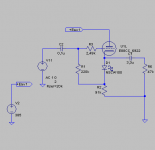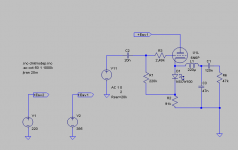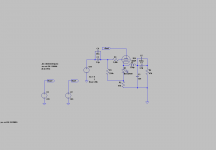I have receive the service manual - thank you very much for your efforts.Sending, hope you can receive ca. 6 MB
Merry Christmas and a Happy New Year
The LC7881 is a lovely sounding ladder dac chip. It just needs good peripherals, i.e., clean power, good output stages, to sound really quite beautiful.
What you are attempting to assemble is almost exactly a Jolida JD601A, the best of all Jolida players. While based on a different, even more common Sanyo player, it uses the same 7881 dac & probably near identical output circuits. The Jolida, strangely, adds the tube stage after the opamp stages, yet still manages to sound good, at least with nice old Dutch, W. German or British tubes installed. I would never use a 6N1 unless I wanted it to sound no better than a transistor stage. While the tubes come after the opamps, there is no good reason to do this, since the 7881 has it's I/V opamps internal, so is voltage out. So, on the 601A currently in my shop, I will be simply moving the input of the tube stage directly to the dac output, bypassing the opamps. This should sound great with no other alterations, since the DF is 8X OS in the 601A, and I'm sure the CEC is at least 4X, so the LPF is not strictly necessary. I'll be doing this mod in the next few weeks.
What you are attempting to assemble is almost exactly a Jolida JD601A, the best of all Jolida players. While based on a different, even more common Sanyo player, it uses the same 7881 dac & probably near identical output circuits. The Jolida, strangely, adds the tube stage after the opamp stages, yet still manages to sound good, at least with nice old Dutch, W. German or British tubes installed. I would never use a 6N1 unless I wanted it to sound no better than a transistor stage. While the tubes come after the opamps, there is no good reason to do this, since the 7881 has it's I/V opamps internal, so is voltage out. So, on the 601A currently in my shop, I will be simply moving the input of the tube stage directly to the dac output, bypassing the opamps. This should sound great with no other alterations, since the DF is 8X OS in the 601A, and I'm sure the CEC is at least 4X, so the LPF is not strictly necessary. I'll be doing this mod in the next few weeks.
I agree. Even in a standart configuration it sounds better than some other IMO. Examples are the NAD models 5320 and 5325, that always sounds better than the model 502 and its derivatives (512, 514 and so on).The LC7881 is a lovely sounding ladder dac chip. It just needs good peripherals, i.e., clean power, good output stages, to sound really quite beautiful.
BTW - despite the lowest price class the models 5320+5325 uses an optical pickup (laser unit) from Olympus with a glass lens instead that one of plastic like the most other - check out for pictures this threads:
post #9 about
http://www.diyaudio.com/forums/digital-source/156478-yamaha-cdx-1110-worth-modding.html
and
http://www.diyaudio.com/forums/digital-source/142817-changing-taohs-jp3-vs-taohs-kp1.html
Mean you the version from the jpeg attachments?What you are attempting to assemble is almost exactly a Jolida JD601A, the best of all Jolida players. While based on a different, even more common Sanyo player, it uses the same 7881 dac & probably near identical output circuits. The Jolida, strangely, adds the tube stage after the opamp stages, yet still manages to sound good, at least with nice old Dutch, W. German or British tubes installed. I would never use a 6N1 unless I wanted it to sound no better than a transistor stage. While the tubes come after the opamps, there is no good reason to do this, since the 7881 has it's I/V opamps internal, so is voltage out. So, on the 601A currently in my shop, I will be simply moving the input of the tube stage directly to the dac output, bypassing the opamps. This should sound great with no other alterations, since the DF is 8X OS in the 601A, and I'm sure the CEC is at least 4X, so the LPF is not strictly necessary. I'll be doing this mod in the next few weeks.
Which model No is the associated SANYO serial version? And I want to know the name of the SONY loader for the KSS-210A (predecessor of the KSM/KSL-210A with aluminium instead plastic clamper assembly) ?
Thank you for an advice.
Attachments
-
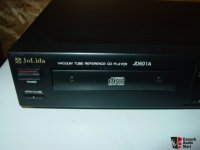 Jolida JD601A front tray aera.jpeg49.8 KB · Views: 225
Jolida JD601A front tray aera.jpeg49.8 KB · Views: 225 -
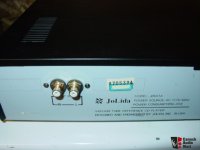 Jolida JD601A rear.jpeg52.6 KB · Views: 98
Jolida JD601A rear.jpeg52.6 KB · Views: 98 -
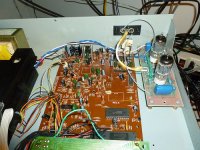 Jolida JD601A PCB for Decoding and filtering.jpeg160.7 KB · Views: 124
Jolida JD601A PCB for Decoding and filtering.jpeg160.7 KB · Views: 124 -
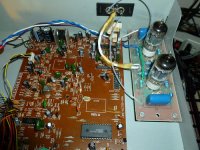 Jolida JD601A PCB aera.jpeg157.7 KB · Views: 213
Jolida JD601A PCB aera.jpeg157.7 KB · Views: 213 -
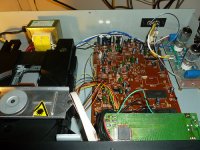 Jolida JD601A MCU+display-driver-front PCB.jpeg157.3 KB · Views: 214
Jolida JD601A MCU+display-driver-front PCB.jpeg157.3 KB · Views: 214 -
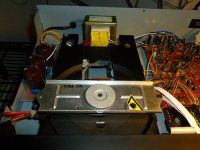 Jolida JD601A Loader for KSS-210A.jpeg131.6 KB · Views: 218
Jolida JD601A Loader for KSS-210A.jpeg131.6 KB · Views: 218 -
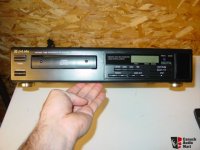 Jolida JD601A front.jpeg83.1 KB · Views: 208
Jolida JD601A front.jpeg83.1 KB · Views: 208
Last edited:
I've never heard ANY tube from anywhere east of W. Germany that I would want to have in any piece of audio gear I'd own or recommend, nor any tube made after about 1975.
I have not nailed down the specific original Sanyo model of the Jolida 601A. The photos you have are the right one, yes. If you look closely, you'll see right away that it uses an entirely Sanyo transport, with an SF-P1 or SF-90 laser(blanking on which, but these two are interchangeable, as I recall). Extremely reliable lasers, in my experience. Just got the LC7860 dsp/DF needed to repair the 601A that's to be upgraded, so may get to it sooner than a few weeks.
I have not nailed down the specific original Sanyo model of the Jolida 601A. The photos you have are the right one, yes. If you look closely, you'll see right away that it uses an entirely Sanyo transport, with an SF-P1 or SF-90 laser(blanking on which, but these two are interchangeable, as I recall). Extremely reliable lasers, in my experience. Just got the LC7860 dsp/DF needed to repair the 601A that's to be upgraded, so may get to it sooner than a few weeks.
But you have heard the tube I mention above, haven't you?I've never heard ANY tube from anywhere east of W. Germany that I would want to have in any piece of audio gear I'd own or recommend, nor any tube made after about 1975.
First attemp - works
It is late, so no power tests cannot be carried. Recheck sims, soldered and it works. I did not check GND connection between CD player and tube output stage at first run. Now corrected and it seems fine (GND connected to pin 17 of LC7881). Both grids connected directly to LC7881 via 0,1uF MKP caps
Enough for today.
It is late, so no power tests cannot be carried. Recheck sims, soldered and it works. I did not check GND connection between CD player and tube output stage at first run. Now corrected and it seems fine (GND connected to pin 17 of LC7881). Both grids connected directly to LC7881 via 0,1uF MKP caps
Enough for today.
Attachments
Last edited:
Listening tests done - bass is more controlled, mids and highs much clearer. Yet some hiss can be heard. HF oscillations? Anyway, better listenig impressions than standard SS opamps stages.
Tried E88CC, 6H1Pi and 6H6Pi. Unfortunately the only tube west of Germany I have is E182CC by Edicron. I will try that one later. After I eat shrimps and some Sav Blanc from NZ.
Tried E88CC, 6H1Pi and 6H6Pi. Unfortunately the only tube west of Germany I have is E182CC by Edicron. I will try that one later. After I eat shrimps and some Sav Blanc from NZ.
Specifically, I consider the Holland Amperex 6DJ8/ECC88, whether "Bugle boy", "globe logo" or etc., the best 6V twin triode for audio. 2nd choice, W. German Telefunken 6DJ8. 3rd, UK-made Mullard 6DJ8. 4th would be various USA-made 6DJ8/6922, but these are all significantly less lovely sounding than my top 3 choices. Never heard any advantage in any European E88CC/6922/7308 "industrial" types versus the regular ECC88 from the same maker/vintage.
I actually did the "opamp bypass" Jolida JD601A mods 3 days ago, and have the unit running a pink noise cd into dummy load resistors since then & will re-listen on Sunday. However, the results before break in were quite excellent. I'm sure it will prove to sound a good deal better than the 601A with opamps still in path(local friend has one done thus & will be bringing it back over). The 601A uses a 12AX7 SRPP output stage, with so much gain that it actually has a 1/10 voltage divide on the input, i.e., a 220K series resistor followed by 22K shunt. Listening done with a pair of Dutch Amperex 12AX7's from about 1965. Really shocking how good that LC7881 can sound. To couple the 7881 output to the tube stage, I used a 22uf Nichicon MuseKZ + 1uf polyester film bypass to input each channel of the tube stage. So, not even remotely a "maximum quality" upgrade, yet it sounds really beautiful.
Stephensank,
Do you know what output impedance of LC7881 is?
No idea, and the datasheet does not specify.
Corrected final
Values of input and output caps were too low. C3 was 10x too high. Resoldered. Now is fine and final. Why I thought 20nF was enough?
Mains transfomer is always on, so I added a relay circuit for switching on HV and filament voltage when power on button is pushed. Base of the transistor is connected to Q014 collector via 27k resistor. Voltage on the collector dropped from +3,7V to +3,6V.
Values of input and output caps were too low. C3 was 10x too high. Resoldered. Now is fine and final. Why I thought 20nF was enough?
Mains transfomer is always on, so I added a relay circuit for switching on HV and filament voltage when power on button is pushed. Base of the transistor is connected to Q014 collector via 27k resistor. Voltage on the collector dropped from +3,7V to +3,6V.
Attachments
Last edited:
In the Jolida's LC7881-SRPP circuit, I deliberately did not install any lowpass filtering, and the sound is silky smooth. I would think it should be the same if you delete the L/C filter from the output of your circuit. With 4x OS and tube, you shouldn't strictly need it.
When it comes to interstage coupling, if I must have a cap, as is the case with the 7881, due to it's 1/2 V+ output dc level, I always go overkill large value, so as not to have any low frequency loss. Don't care if it's technically correct or not, it works & I like it. Same goes, even more so, for final output coupling caps.
When it comes to interstage coupling, if I must have a cap, as is the case with the 7881, due to it's 1/2 V+ output dc level, I always go overkill large value, so as not to have any low frequency loss. Don't care if it's technically correct or not, it works & I like it. Same goes, even more so, for final output coupling caps.
- Status
- This old topic is closed. If you want to reopen this topic, contact a moderator using the "Report Post" button.
- Home
- Source & Line
- Digital Source
- CEC 780CD tube buffer based on 6n1p cathode follower
